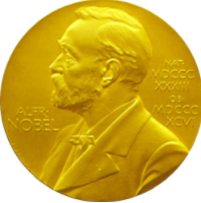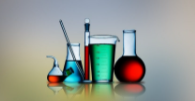The Nobel Prize for Chemistry

November 15, 2021
Every year, Nobel Prizes are awarded to outstanding people. This year in the Chemistry subject, the two winners were Benjamin List and David MacMillian.
What is the Nobel Prize?
The Nobel Prize is an award created by Alfred Nobel. In the Prize, there are six subject areas. The subjects are medicine, physics, chemistry, economics, literature, and peace. A group in Norway determines who wins the Peace Prize, while a group in Sweden chooses who wins the other awards.
There is a banquet held in Stockholm, Sweden where the winners each receive a gold medal and 1.1 million dollars! The Prizes, such as 2021’s chemistry, can be shared between multiple people, but only the Nobel Peace Prize can be won by an organization.
Chemistry Prize 2021
 This year’s chemistry Prize was shared between two scientists: Benjamin List and David MacMillian, for developing a new way to construct molecules. They call it organocatalysis (orgin⋅oh⋅kuh⋅tah⋅li⋅sis). To put it in a nutshell, organocatalysis is when there is a base of molecules that other molecules are able to attach to in order to form a new substance.
This year’s chemistry Prize was shared between two scientists: Benjamin List and David MacMillian, for developing a new way to construct molecules. They call it organocatalysis (orgin⋅oh⋅kuh⋅tah⋅li⋅sis). To put it in a nutshell, organocatalysis is when there is a base of molecules that other molecules are able to attach to in order to form a new substance.
Many industries and research areas need chemists to build molecules that will form an elastic, yet durable, material. To do this, chemists need catalysts (kat⋅a⋅lists).
Catalysts are substances that modify chemical reactions, but they won’t be present in the final product. Before List and MacMillian discovered this new way to build molecules, chemists believed that there were only two types of catalysts available: metals and enzymes. Enzymes are the critical substances our bodies use to stay alive.
The New Catalysis
In 2000, independently, List and Macmillian both created a new type of catalyst. The new catalyst, asymmetric organocatalysis, is an eco-friendly way to construct molecules.
The chair of the Nobel Committee for Chemistry, Johan Åqvist states, “This concept for catalysis is as simple as it is ingenious, and the fact is that many people have wondered why we didn’t think of it earlier.”
Organic catalysts, like the organocatalysis that List and MacMillian developed, have a structure of carbon atoms that other atoms can attach to. Some of the atoms that can attach to the carbon are oxygen, nitrogen, sulfur or phosphorus. Therefore, because we use pre-existing, natural materials, these catalysts are eco-friendly and inexpensive to produce.
The main reason why we use organic catalysts is because of their capability to create asymmetric catalysis. What that means is that when molecules are being constructed, it often happens that two molecules are formed- which are also mirror images. However, chemists usually only want one of these, especially when producing medicine.
List and MacMillian’s organocatalysis has been altered and improved at an outstanding rate since the 2000s. List and MacMillian remain to be leaders in the subject. They have also proved that organocatalysis can be used to create lots of chemical reactions.
Using these chemical reactions, scientists can do loads of things. So far, they are using organocatalysis to create new medicines and develop more powerful solar cells. In conclusion, while being cost effective, eco-friendly and super cool, this year’s chemistry Nobel Prize was the right choice!
Works Cited
Encyclopædia Britannica, Encyclopædia Britannica, Inc., kids.britannica.com/students/article/Nobel-Prize/276112.
“The Nobel Prize in Chemistry 2021.” NobelPrize.org, www.nobelprize.org/prizes/chemistry/2021/press-release/.
“The Nobel Prize in Chemistry 2021.” NobelPrize.org, www.nobelprize.org/prizes/chemistry/2021/press-release/.




